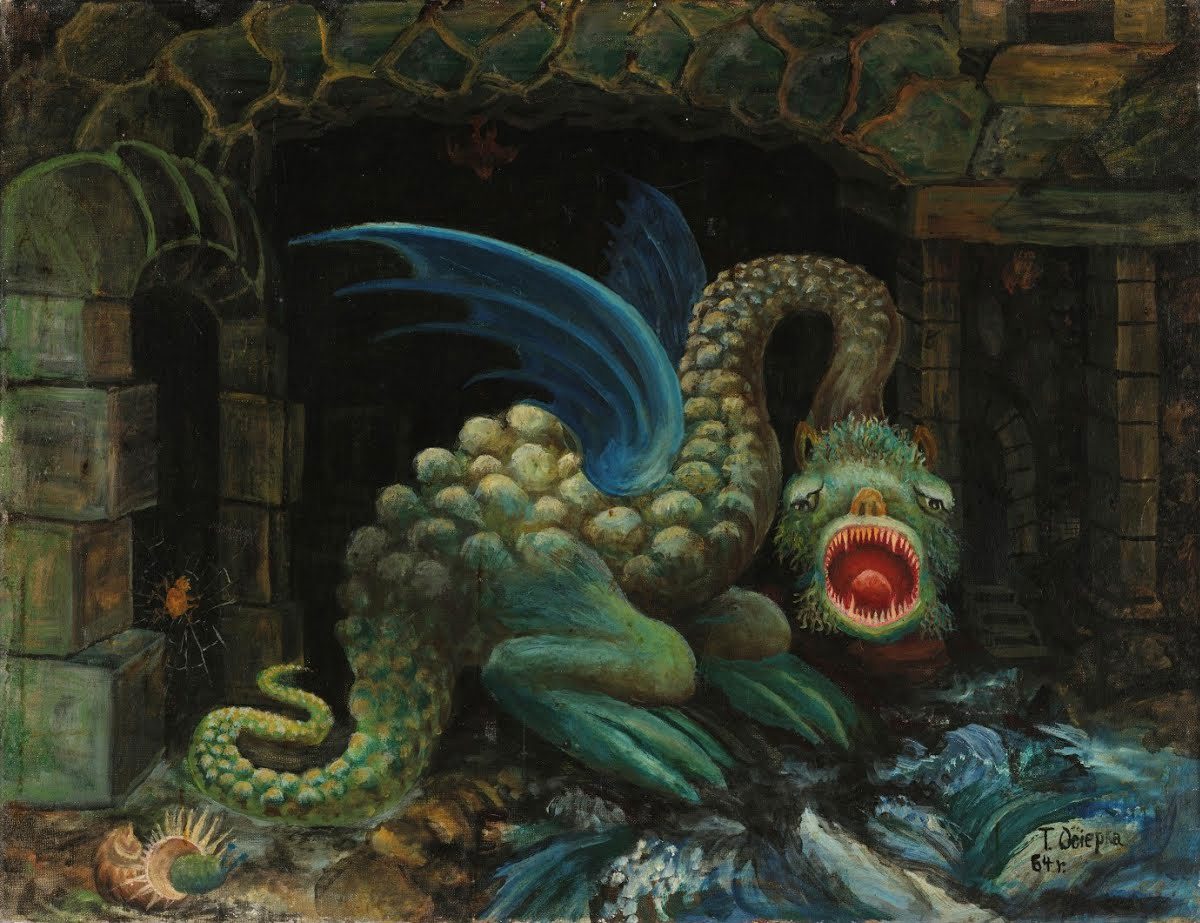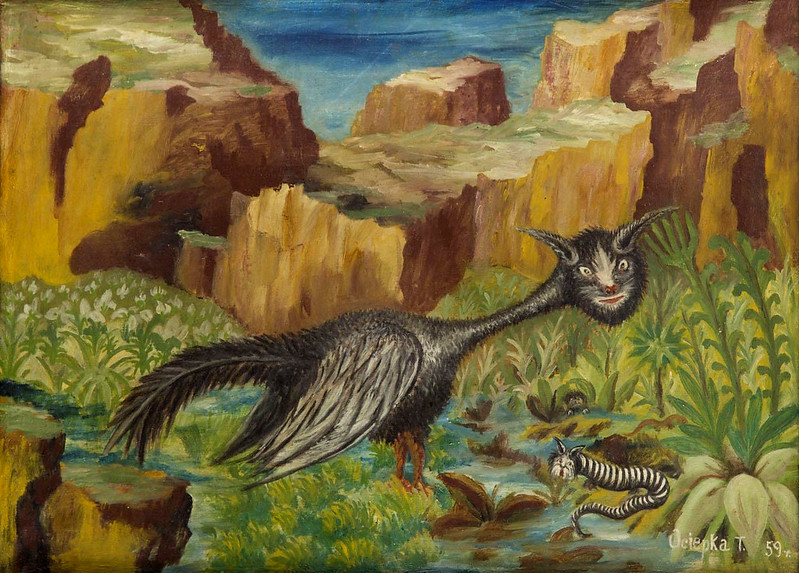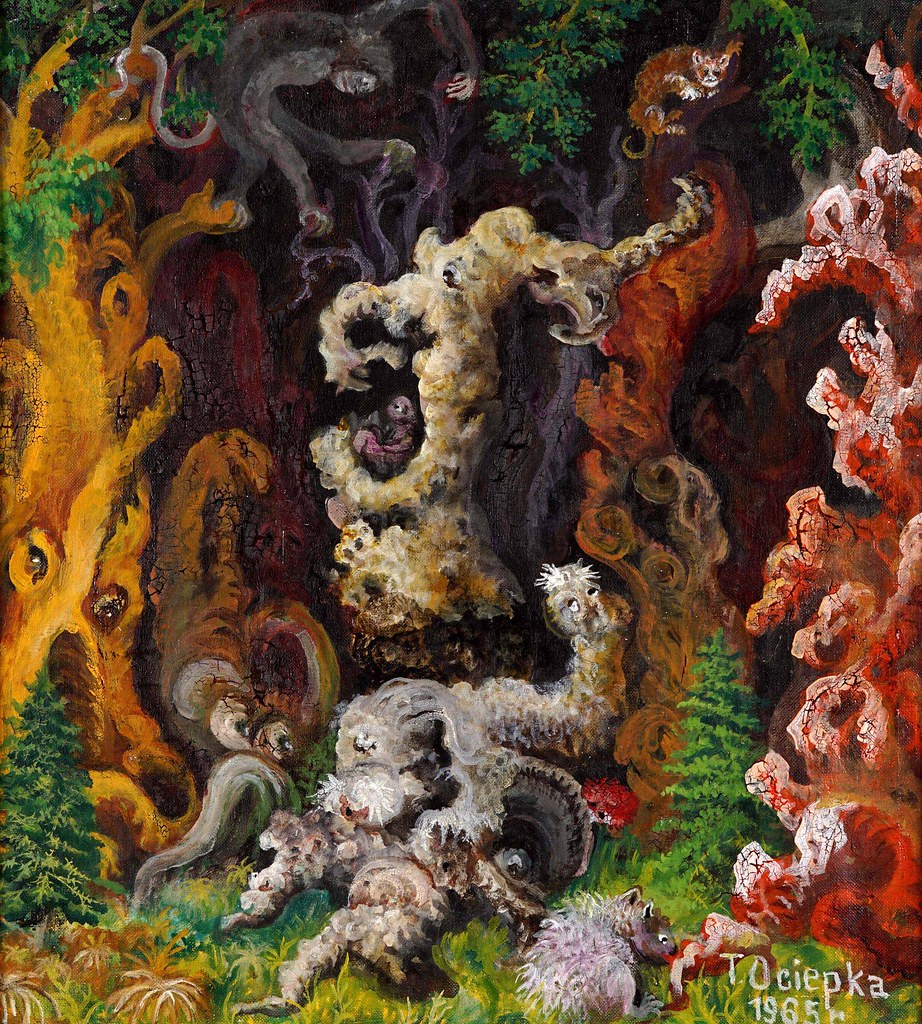 The Spirit of the Forest, 1963
The Spirit of the Forest, 1963
 Teofil Ociepka with his family, 1973, photo by Janusz Rosikoń
Teofil Ociepka with his family, 1973, photo by Janusz Rosikoń
"Teofil Ociepka (April 22, 1891 in Janów Śląski – January 15, 1978 in Bydgoszcz) was a Polish self-taught primitivist painter, occultist, and theosophist. Along with Nikifor, he was one of the best known Polish primitivists.
His occupation was a miner, working at the Giesche's coal mine in Katowice as a machinist in the power plant. During World War I he served as a soldier in the German Army, where he was introduced to occultism. When he returned to Janów, he brought back with him the first works on occultism, including Athanasius Kircher's treatise on the Seventy Two Names of God. On the recommendation of his Swiss mentor, Philip Hohmann of Wittenberg, with whom he maintained steady correspondence, Ociepka became a member of the Rosicrucian Lodge and attained the status of Master of Secret Sciences. On Hohmann's direction, he organized a strong occultist community in Janów. He maintained contact with the Julian Ochorowicz Parapsychological Society of Lvov. He believed that he had a spiritual link with his master who telepathically inspired his art. Hohmann persuaded Ociepka to start painting circa 1927. He gave up his attempts in 1930 after receiving criticism from Tadeusz Dobrowolski, a Polish professor of art history and museum curator. He probably returned to painting either before or during World War II.
After the war, he gained a supporter in the author Isabel Czajka-Stachowicz, who in 1948 organized for him an exhibition in Warsaw, promoting him as "Polish Douanier Rousseau." She was aided by her friends, Julian Tuwim and Jan Kott. The Warsaw exhibition launched Ociepka's great world-class artistic career.
He saw his painting as God's mission, and so tried to portray absolutist themes, including the struggle between Good and Evil. His paintings depicting the imaginary fauna and flora of Saturn relate to the Rosicrucian ideology. During the early 1950s, in an attempt at political correctness, they were interpreted as Paleozoic Era landscapes. Later, his works depicted themes from fairy tales, legends, and lives of miners. They are characterized by wealth of imagination and bright, rich colors. The themes of his works, especially those from before 1956, were criticized as not adhering to the canon of socialist realism.
In 1946 Ociepka partnered with Otto Klimczok to found an art group. In 1947 the group was reorganized as an Art Circle associated with the Cultural Center "KWK Wieczorek", which during the 1950s provided a base for a talented group of amateur artists. The group was known as "Janowska Group" after its birthplace, or more formally, as the Circle of Non-professional Painters. Ociepka was a member until 1959, when he permanently moved to join his wife in Bydgoszcz. Under her influence he broke contact with the Janowska Group and distanced himself from occultism. He died on January 15, 1978 from a brain aneurysm." - quote source
"One of the most interesting esoteric-related moments in Teofil Ociepka’s life was his awakening as a painter. Ociepka believed that it was Hohmann who made him an artist with a spiritual purpose. He claimed: “[Hohmann] wrote to me: ‘Teofil, a spirit will come to you and will teach you how to paint.’ I have never seen any spirit, but something Teofil Ociepka - Malarz. Fot. Eustachy Kossakowski/FORUM.undefined was born in my soul, which could be called love for the essence of beauty, that is for God. That was in 1927 and, from that time on, I began to paint and have been painting ever since with unfaltering joy and pleasure.” (Wisłocki 2010:43). " - quote source
The following is a plot description of the 2002 film "Angeleus" directed by Lech Majewski that centers around the artist and his familiar circle of painters.. "In the Polish town of Janow, during the 1930s, an occult commune was formed around Teofil Ociepka, an electrician at the local coal mine and a painter, who became a Master of Esoteric Science. Ociepka and his disciples, simple uneducated miners, searched for the Philosophers Stone and pursued spiritual perfection, which would permit them to penetrate the Principle and the Sense of the World and of God, to reach the mystery of Existence. Their activities combined elements of occultism, alchemy and theosophy with archaic and magical Silesian beliefs. During the bleak desert of the Stalinist era, the "Circle of Janow" marked a colorful metaphysical oasis, and its existence was consequently falsified by the authorities of the People's Republic of Poland." - quote source
While difficult to find, a version of the film in its original language, regrettably without subtitles, was shared on youtube.
An article on the group of coal miner artists associated with Ociepka "Janowska Group" or "the Circle of Non-professional Painters" can be found at Culture.PL "Beneath the Surface: The Occult Inspirations of Poland’s Legendary Naive Artist Coal Miners"



















No comments:
Post a Comment